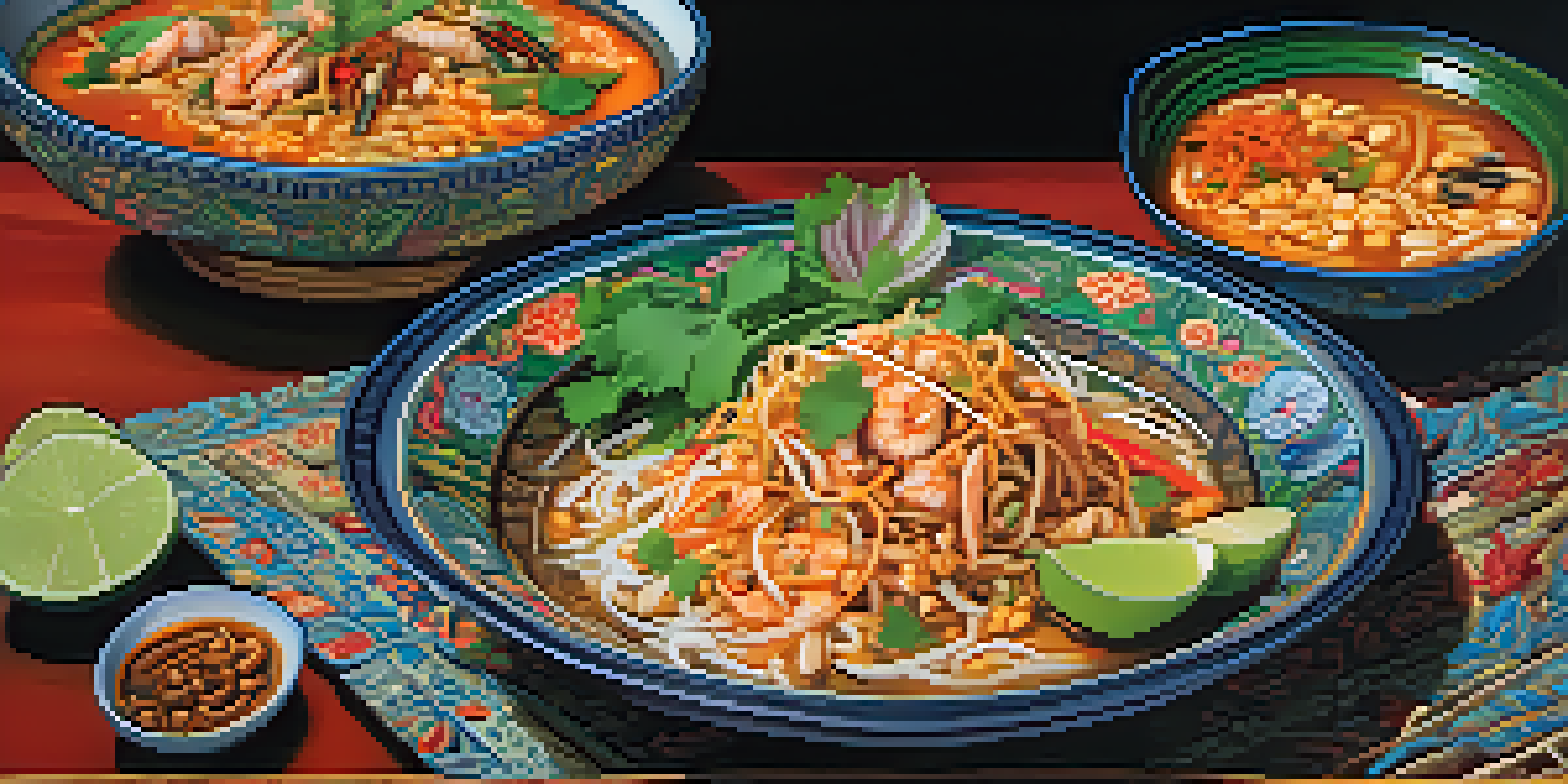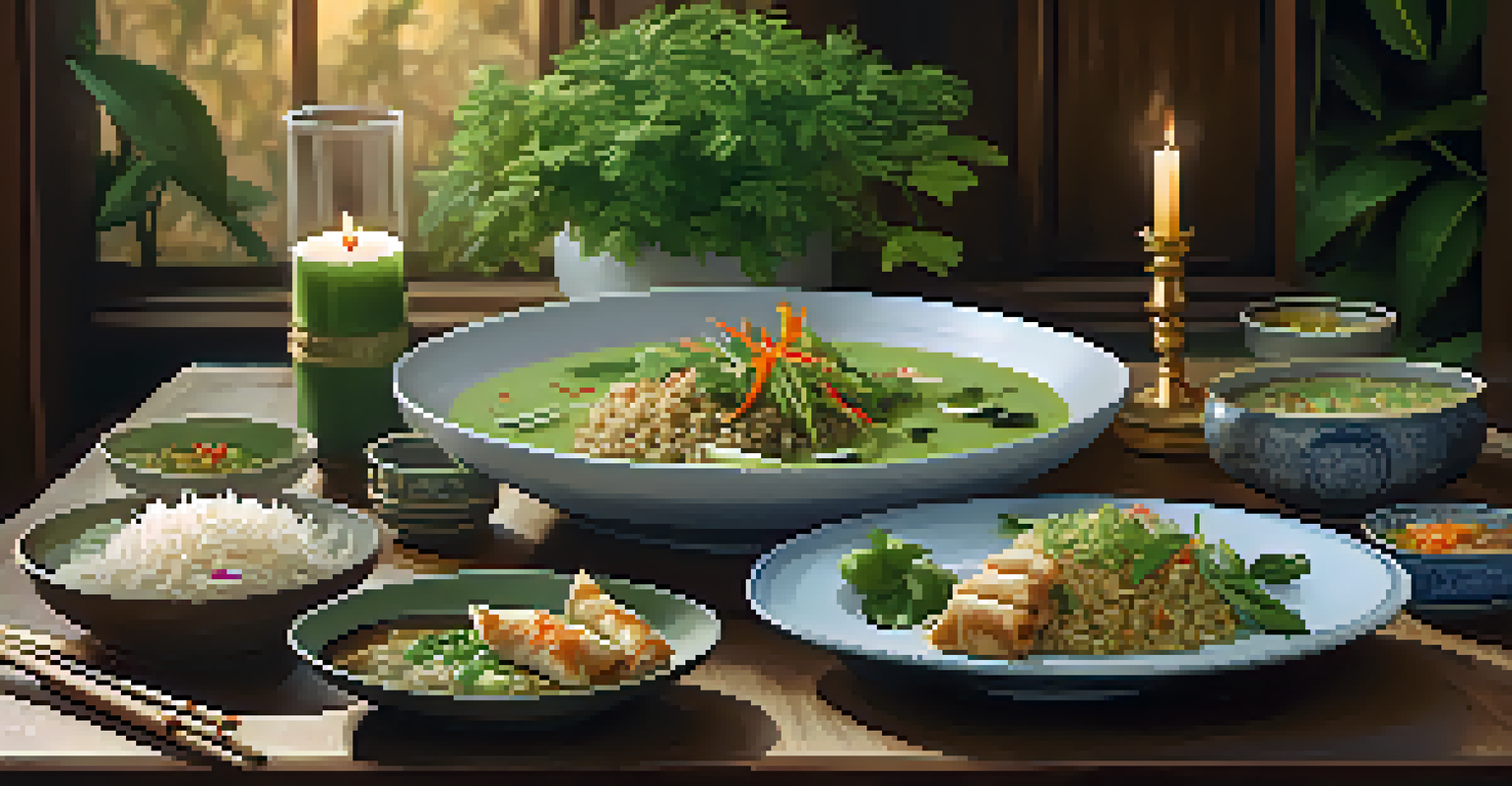Ordering Food in Thai: A Culinary Adventure

Discovering the Richness of Thai Cuisine
Thai cuisine is a delightful blend of flavors, aromas, and textures, making every meal a unique experience. It’s characterized by its balance of sweet, sour, salty, and spicy elements, creating dishes that are both satisfying and exciting. Each region in Thailand has its specialties, from the creamy curries of the south to the spicy salads of the north, reflecting the cultural diversity of the country.
Food is a vital part of a balanced lifestyle.
When you think of Thai food, you might picture a colorful platter of Pad Thai or a steaming bowl of Tom Yum soup. However, there's so much more to explore! Dishes like Som Tum (green papaya salad) and Massaman Curry showcase the variety and depth of flavors that Thai cuisine offers, inviting you to embark on a culinary adventure.
Understanding this vibrant culinary landscape is key to ordering food in Thai. Not only does it enhance your dining experience, but it also allows you to appreciate the rich cultural context behind each dish.
Key Thai Dishes You Should Know
Before diving into ordering, it helps to familiarize yourself with popular Thai dishes. Some classics include Pad Thai, a stir-fried noodle dish often topped with peanuts, and Green Curry, which is known for its fresh herbs and creamy coconut milk. These dishes are often a great starting point for newcomers to Thai food.

Don’t overlook the street food scene, where you can find gems like Satay (grilled meat on skewers) and Mango Sticky Rice, a beloved dessert. Each dish tells a story, often passed down through generations, showcasing local ingredients and culinary techniques.
Explore Diverse Thai Dishes
Thai cuisine offers a rich variety of flavors, from spicy salads to creamy curries, that reflects the country's cultural diversity.
Being aware of these dishes gives you the confidence to order and even try something new. Plus, it’s always fun to impress your dining companions with your knowledge of Thai cuisine!
Basic Thai Phrases for Ordering Food
Learning a few basic Thai phrases can enhance your dining experience significantly. Phrases like 'khun chao arai?' (What would you like?) and 'ao...?' (I would like...) are simple yet effective. They show respect for the culture and can often lead to a more personal interaction with the staff.
Eating is a necessity, but cooking is an art.
Another useful phrase is 'phet nit noi' (a little spicy), which can help tailor your dish to your taste. Thai food is known for its bold flavors, and understanding how to communicate your preferences can make all the difference.
Remember, a smile goes a long way! Engaging with the staff in their language not only helps you order but also creates a friendly atmosphere, making your culinary adventure even more enjoyable.
Understanding the Menu: What to Look For
Thai menus can be a feast for the eyes but sometimes overwhelming. It's beneficial to look for sections that categorize dishes by type, such as curries, soups, and salads. Many menus also highlight popular dishes, which can serve as a safety net for those unsure of what to order.
Pay attention to symbols or notes that indicate spiciness levels or vegetarian options. Familiarizing yourself with common ingredients can also help you navigate the menu more easily. For instance, knowing that 'nam pla' means fish sauce can help you decide if a dish aligns with your dietary preferences.
Learn Basic Thai Phrases
Knowing a few simple Thai phrases can enhance your dining experience and foster a more personal interaction with restaurant staff.
Taking the time to understand the menu can turn your dining experience from confusing to delightful, allowing you to make informed choices that suit your palate.
Navigating Dietary Restrictions in Thai Cuisine
If you have dietary restrictions, communicating them clearly is essential. Many Thai dishes can be easily modified to accommodate vegetarian, vegan, or gluten-free diets. For example, you can request a vegetarian version of a curry by saying 'mai sai neua' (no meat).
Thai restaurants are often quite accommodating, but it’s important to specify what you can or cannot eat. This not only ensures your meal is safe but also enhances your overall dining experience by allowing you to enjoy the food without worry.
Being clear about your dietary needs also helps create a more enjoyable atmosphere for everyone involved, allowing you to explore the rich flavors of Thai cuisine without compromise.
The Art of Eating Thai Food
Thai meals are usually served family-style, encouraging sharing and interaction. This communal approach makes dining a fun experience, as you can sample a variety of dishes. It's common to share several plates, allowing everyone to indulge in the flavors of the meal together.
Don’t be surprised if you’re offered a side of rice with your dishes; it’s often the perfect accompaniment to balance the bold flavors of curries and stir-fries. Using a fork and spoon is standard in Thailand, with the spoon being your primary utensil, making it easy to scoop up food.
Communal Dining Experience
Thai meals are typically served family-style, encouraging sharing and making the dining experience more interactive and enjoyable.
Embracing the communal style of eating not only enhances your experience but also allows you to connect with your dining companions over a shared love for delicious food.
Tips for Enjoying Your Thai Dining Experience
To truly enjoy your Thai dining experience, take your time and savor each dish. Thai meals are crafted to offer a balance of flavors, so really engage your senses. Notice the vibrant colors, inhale the aromas, and appreciate the textures as you eat.
Don’t hesitate to ask your server for recommendations. They often have insights into the best dishes or seasonal specialties that you won’t want to miss. Plus, they can provide stories behind the dishes, adding depth to your culinary adventure.

Lastly, be open to trying new things! Thai cuisine is filled with surprises, and embracing the unexpected can lead to discovering new favorites.